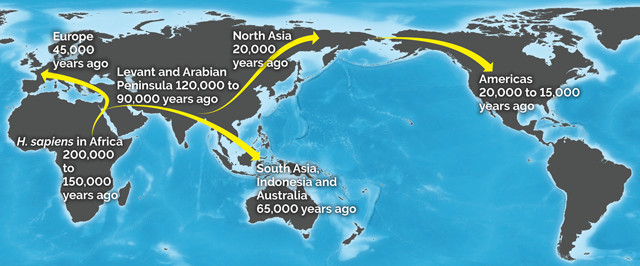
by Mary Caperton Morton Friday, February 23, 2018

Homo sapiens, which first emerged in Africa between 150,000 and 200,000 years ago, migrated in waves to different parts of the world. Credit: K. Cantner, AGI.
Genetics studies have dated the largest migrations of early Homo sapiens out of Africa to between 70,000 and 55,000 years ago, although smaller groups may have left earlier. The most widely accepted exodus theory, known as the “green carpet” or “green Sahara” hypothesis, holds that people likely left during wetter periods in the Sahara and Arabia, which would have allowed easier passage into Eurasia via the Middle East. But new research supports the opposite idea: that drier conditions may have triggered at least some of the exodus.
“It’s fascinating to think about how our ancestors interacted with changing climatic conditions, but we know surprisingly little about what climate was doing during the time period when people were first leaving Africa,” says Jessica Tierney, a geoscientist at the University of Arizona and lead author of the new study, published in Geology. To date, the most complete climate records for eastern Africa — where early humans were concentrated — have been found in sediment cores collected from the Gulf of Aden between modern day Somalia and Yemen. But due to ongoing threats from pirates, researchers haven’t been able to collect new sediment cores there since 2001. So Tierney and her colleagues turned to a core originally collected from the Gulf of Aden in the 1960s and now stored at Columbia University’s Lamont-Doherty Earth Observatory in New York.
Sediments in the core used by Tierney’s team date back more than 200,000 years and contain two sources of climate data: stable hydrogen isotopes in ancient leaf waxes that record past precipitation levels on land, and fossils of marine algae, which can be used to reconstruct sea-surface temperature records. The researchers found that a prolonged dry period began roughly 70,000 years ago and lasted as long as 15,000 years, lasting through the window in which genetics studies have placed the largest migrations from Africa. “This finding was somewhat surprising to us, because most of the views expressed in the literature always assumed that migrations occurred when [the climate] was wetter,” she says, “simply because it’s easier to move when it is wetter.”
The new core is a welcome addition to the sparse paleoclimate record from eastern Africa, says Huw Groucutt, an archaeologist at the University of Oxford in England who was not involved in the new study. “Before this new record, there was quite a big gap in both time and space [in the available data]. It’s always good to get a new piece of the puzzle, especially since different kinds of paleoclimate records have different strengths and weaknesses.” But Groucutt also says that data from one sediment core is not enough to throw out the green carpet hypothesis altogether. Africa is a huge continent that often exhibits a high degree of climate variability, he notes, and while it may have been dry in one area, it may have been wet in others at the same time. “The most fundamental story is that to leave Africa, you have to cross a big desert belt [the Sahara], and every so often, this belt gets wetter and there are lakes and rivers to aid the crossing. I don’t think this new paper changes that story,” he says.
“There was probably more than one migration — it likely occurred in waves — but the biggest ones must have occurred during this dry period, which would have been drier than present-day Africa and much colder,” Tierney says. “People migrate in response to drought all the time, so it’s not unreasonable to think some of these early migrations may have been drought-related.”
© 2008-2021. All rights reserved. Any copying, redistribution or retransmission of any of the contents of this service without the expressed written permission of the American Geosciences Institute is expressly prohibited. Click here for all copyright requests.